From Touchpoint to Focal Point—Championing Mobile App Adoption for QSR
Published on Mar 16, 2022
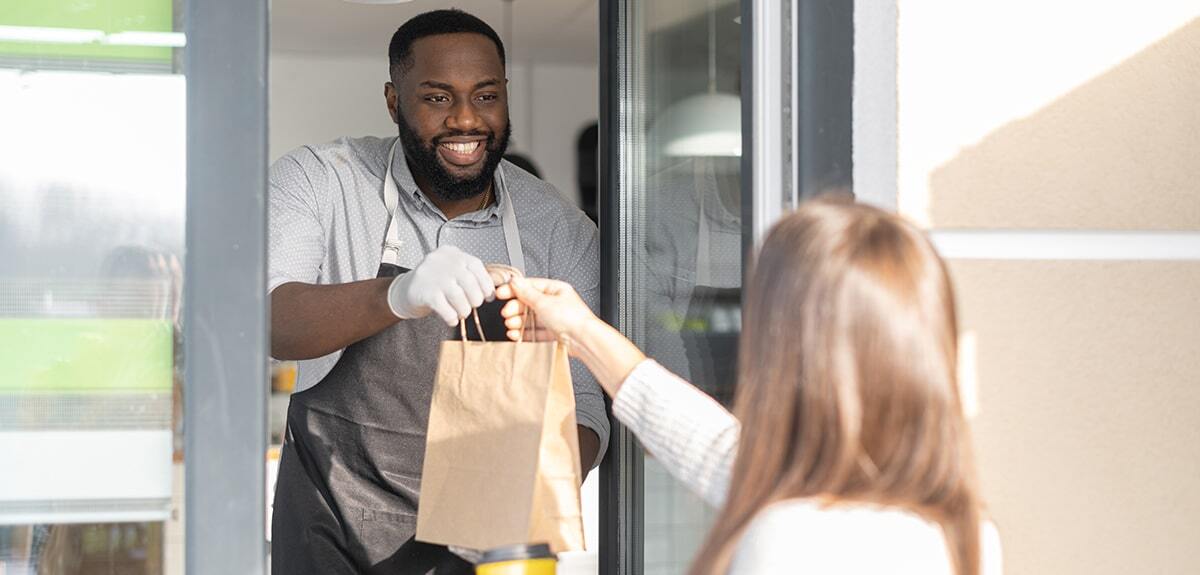
If you asked a QSR brand about its app strategy a decade ago, you’d probably hear about things like price consideration, caloric intake concerns, and deep fryer capacity. Today, you’re more likely to get a readout of hardline metrics like daily active users, customer lifetime value, and ROI.
That’s because the perpetually looming digital transformation—well underway for the past several years—was especially accelerated in the restaurant industry, as the onset of the pandemic ushered in fundamental changes to the customer experience and a litany of operational complexities.
As dining rooms closed and people shifted to digital channels for off-premise orders, new behavioral trends quickly became a leading indicator for where companies should invest resources to future-proof their brands.
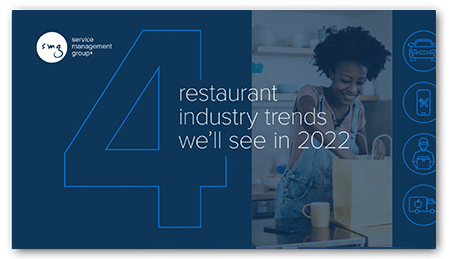
Lean in on these 4 restaurant industry trends to reestablish momentum
To capitalize on this growing area of opportunity for more frequent, smarter customer engagements, here are 3 trends in mobile app adoption QSR brands need to consider:
Trend #1: QSR mobile app adoption continues to rise, but there’s ample opportunity to drive usage
While research shows there are more than 80 apps installed on the average mobile device, users only engage with 9 apps per day and roughly 30 apps each month. Excluding basics like messaging apps, calendars, and social media, it’s easy to see why not too long ago, the idea consumers would need, install, and use a mobile application for fast-food orders would have seemed like an aspirational pipedream for QSR marketing teams.
But times have changed.
In a 2017 study conducted by SMG, 62% of respondents reported they had zero restaurant apps installed on their mobile devices. In our most recent study—based on feedback and behavioral data from more than 8,000 consumers—83% of respondents said they have at least one QSR app, and 36% said they have 5 or more (4% pts higher than last year).
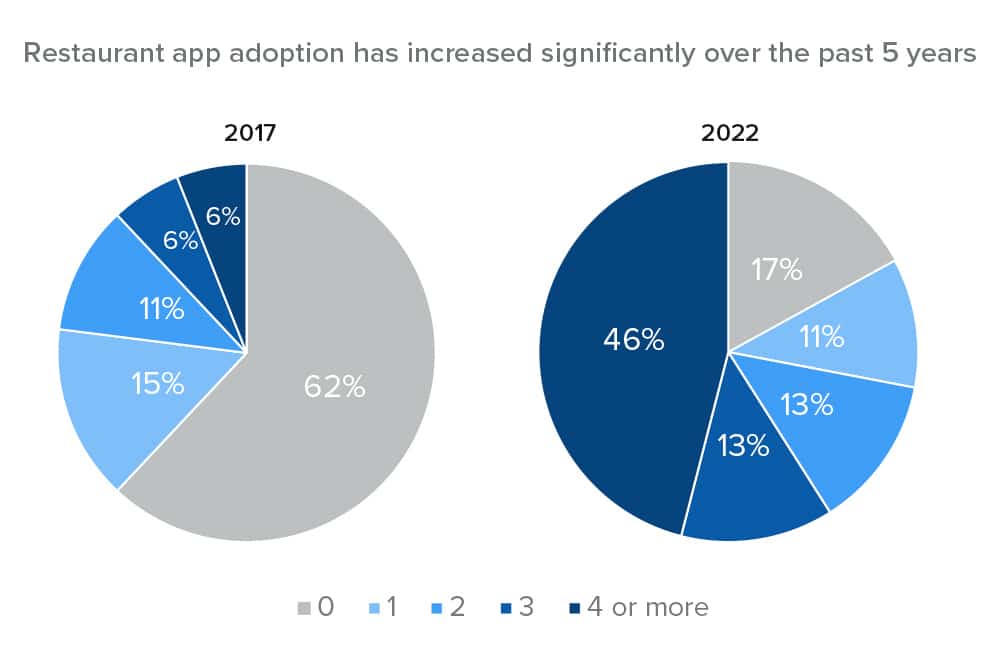
While every brand we measured experienced year-over-year growth in mobile app installs compared to SMG’s 2021 study, McDonald’s, Wendy’s, and Taco Bell saw the greatest gains.
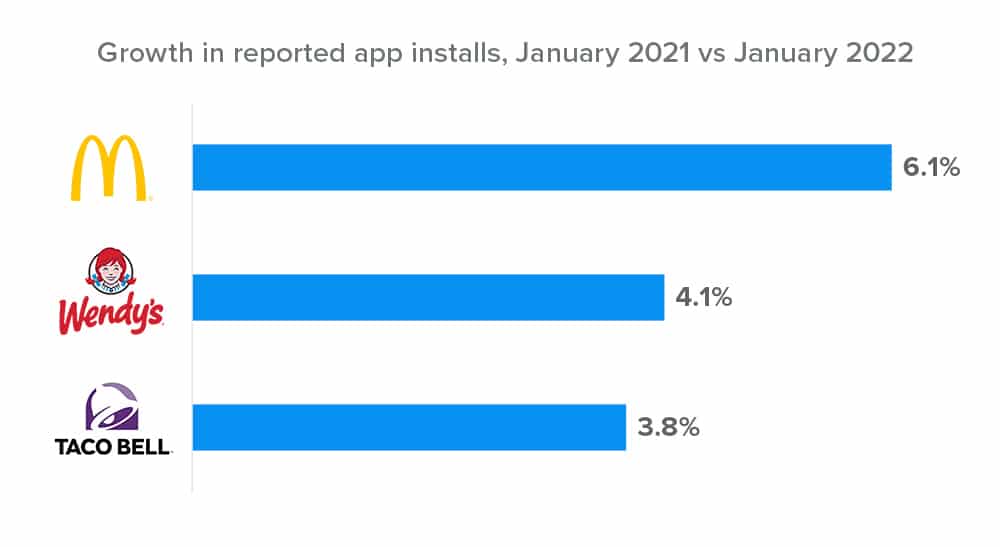
But as a KPI, total number of downloads pales in comparison to actual usage metrics. Of the 83% of consumers who have at least one QSR app installed on their phones, more than one in three had not used a restaurant app to place an order in the past 30 days.
To evolve past being a novel touchpoint, QSR apps must offer their own value proposition that not only aligns with the brand’s existing customer experience but enhances it in tangible ways that benefit the end user. Fortunately, brands are stepping up to that challenge.
Trend #2: QSR brands are finding innovative ways to convert downloaders into repeat users
Delivering a differentiated user experience hinges on understanding the motivations and expectations of the user. By having a firm grasp on the initial intent behind installs, QSR brands will be better positioned to find effective ways to influence future behaviors.
When we asked users about their reasons for downloading and engaging with QSR mobile apps, they reported primarily being lured in by loyalty rewards, the ease of placing and customizing orders, contactless experiences, and app-exclusive deals or promotions.
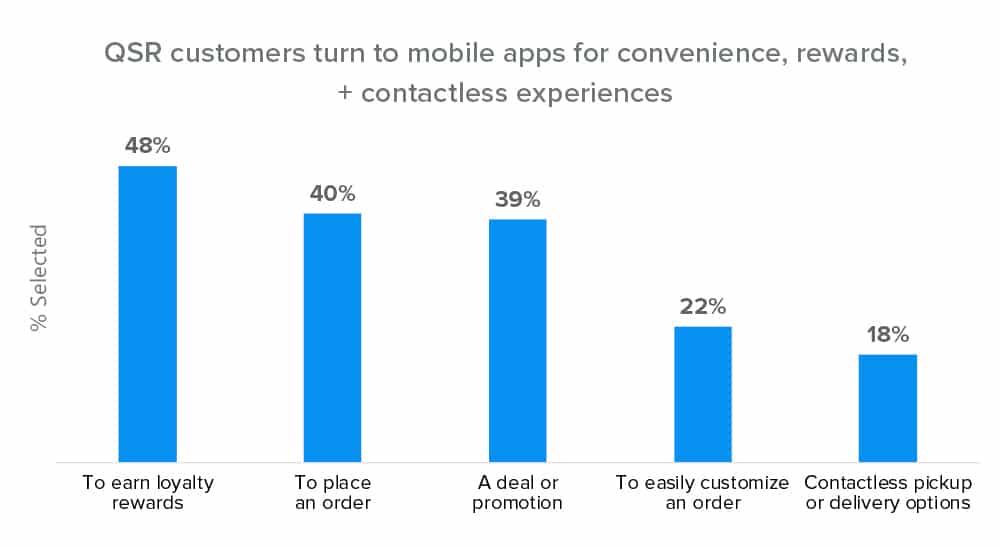
App-exclusives have proven especially effective when it comes to driving downloads. Both McDonald’s and Burger King launched promotions only available through mobile app purchase in December 2021.
For McDonald’s customers, the Mariah Menu offered 12 days of select free items with a minimum $1 purchase via the mobile app, while Burger King offered 57-cent Whoppers to its Royal Perks loyalty program members in honor of the flagship burger’s birthday (and original 1957 price point). According to SimilarWeb data, each of the campaigns sparked an enormous uptick in monthly downloads.
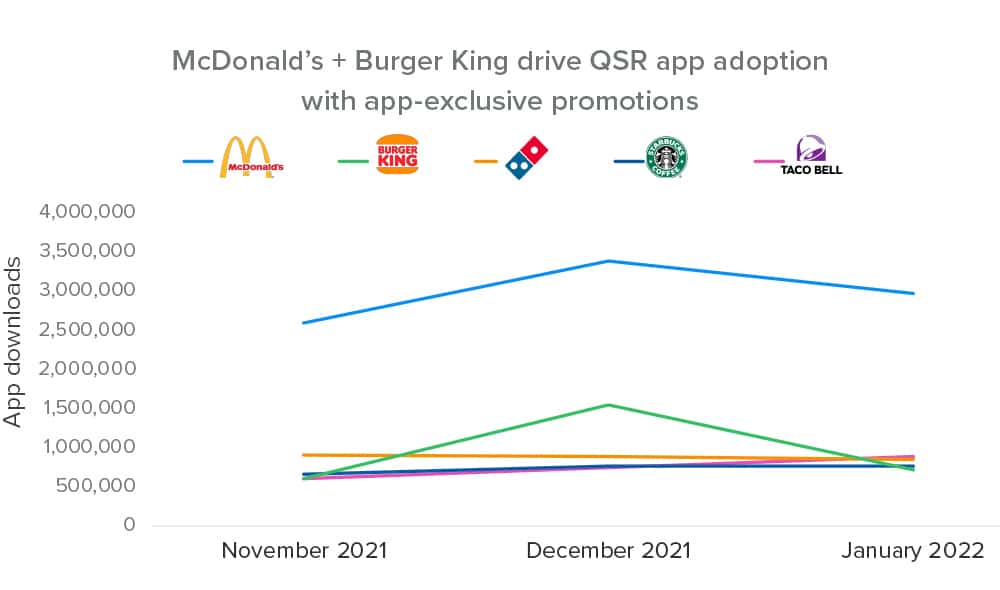
Giveaways can spark early app adoption, but maintaining engagement requires a long-term strategy. Successful apps tend to keep users active by being:
- Convenient: Users can order ahead + bypass lines by tapping the “I’m here” button, with a multitude of mobile-wallet pay options
- Personalized: Orders can be customized + saved for future visits, while users can automatically locate the closest restaurant based on location
- Rewarding: Customers receive usage-based incentives for popular add-on items
While franchisees can be reluctant to embrace loyalty programs and incentives, the benefits far outweigh the negligible costs. For example, SMG research shows customers return more than 10% faster when they redeem an incentive—leading to two additional visits each year on average—and when customers redeem their incentive, they purchase 3 additional items on average, offsetting the cost for operators by boosting average ticket size.
When the app experience delivers on customer expectations, everyone wins. Customers get an easy, convenient way to get what they want. Operators have an additional stream of revenue. Brands benefit from increased loyalty program enrollment, customer-level behavioral data + transaction history, and the ability to deliver hyper-personalized engagements directly to their customer base.
Unfortunately, not every app experience translates to a 5-star review.
Trend #3: QSR app users cite customizations, inaccurate orders, and limited menus as top complaints
The good news: QSR apps have come a long way in the past 5 years. According to the Application Resource Center (ARC), the average mobile sentiment score across all apps in 2017 was 67.3 out of 100—the weighted average for the branded apps of Nation’s Restaurant News Top 100 restaurants was just 37.8. Today, the average star rating for restaurant apps is 4.74 in the App Store and 3.96 in Google Play, showing a marked improvement in customer perception.
The bad news: app-related issues can be difficult to diagnose (or virtually invisible if the user simply gives up and deletes the app without reporting the issue) and even harder to solve, as execution requires both an integrated tech ecosystem and detailed operational strategies for front-line employees tasked with fulfilling orders alongside on-premise traffic.
While 43% of respondents rate the app ordering experience as better or much better than ordering in-person, 13% rate it worse or much worse. From an app functionality standpoint, these users were particularly frustrated with the ordering process itself due to limited app menus, lack of customization options, and general difficulty related to UX.
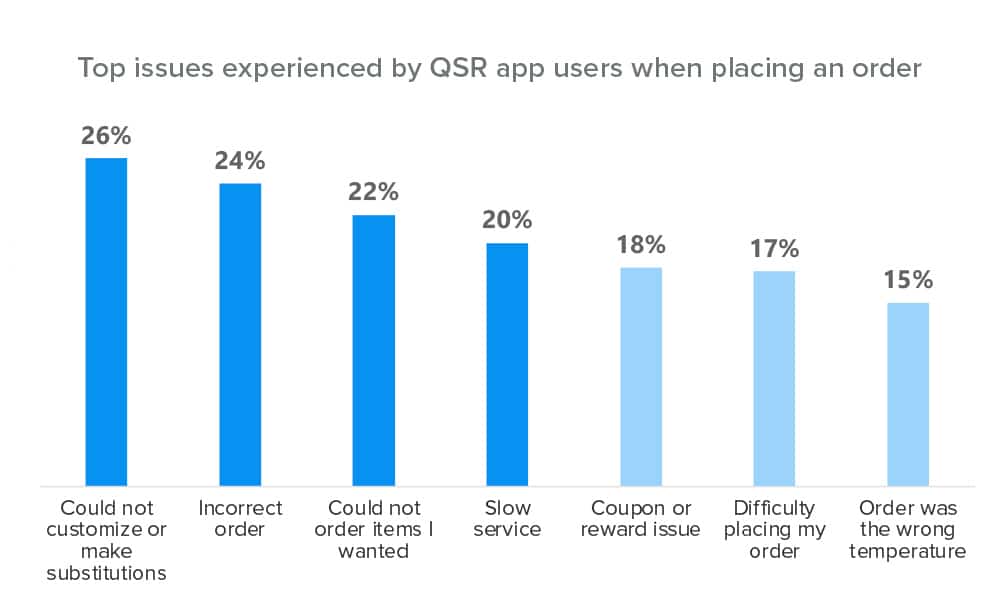
While these technical issues could be tackled by the app development team and solved with an overnight update pushed to the user’s mobile devices, order fulfillment issues—particularly when it comes to order accuracy—warrant a closer look.
As with all off-premise issues, inaccurate orders are notoriously hazardous as customers often don’t realize the mix-up until they’ve sat down to eat their meal. And no matter how stellar the rest of the experience is, it’s unlikely to make up for the fact that the double cheeseburger they were craving has been replaced by a suspiciously lean salad.
For respondents who reported being unlikely or highly unlikely to reorder through the app, the top 2 issues cited were inaccurate orders and the inability to make customizations or substitutions. While the latter could lead to a deleted app, the former could lead to a lapsed customer if it happens enough times.
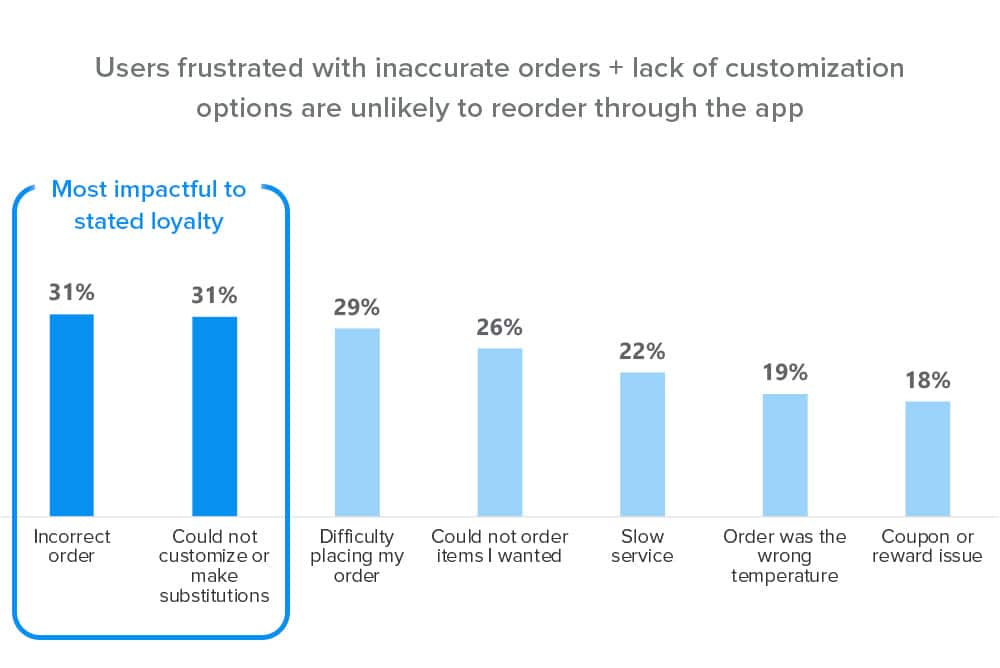
How to drive mobile app adoption for your QSR brand
Like the industry itself, the QSR mobile app market is crowded, competitive, and rapidly evolving. To keep pace, brands must take an agile approach to customer-centric innovation by collecting both active + passive user feedback and using it to inform improvement efforts. To learn how SMG’s in-app feedback capabilities help brands drive smarter customer engagements and increase adoption, reach out to one of our digital CX experts or download the tech one-pager.
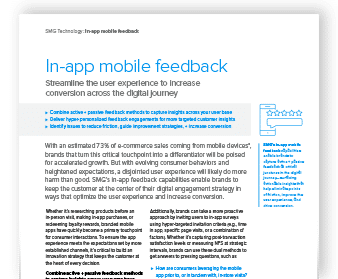
Streamline the app experience to increase conversion across the digital journey
Related articles

Top Trends for your Omnichannel Restaurant Strategy
Omnichannel restaurant strategies need to consider both customers who use tech and those who prefer in-person experiences. Here is how to strike that balance.

Creating a Customer Experience App that Serves Customers First
As of last June, 81% of Americans owned a smartphone. In the throes of this convenience revolution—as more consumers turn to their phones for research and to make purchases—the pressure for brands to

Why QSR brands must invest in digital engagement + mobile app UX strategies in 2021
One of the most tangible examples of 2020's accelerated digital transformation can be found in the QSR segment. Between the months of March and August of 2020, mobile usage increased 40% as safer-at-h